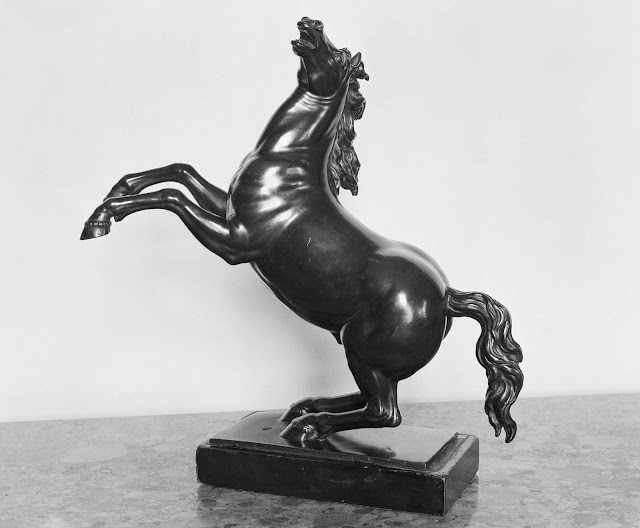 |
| Anonymous British photographer Statue group of Alexander and Bucephalus on the Quirinal Hill ca. 1855 calotype Metropolitan Museum of Art |
 |
| Anonymous photographer Statue group of Alexander and Bucephalus on the Quirinal Hill 19th century photograph Victoria & Albert Museum |
"Although both horses were much repaired they seem to have been more admired than their superhuman companions in most Renaissance accounts of the group. The men are sometimes described as naked slaves in attendance on the horses and are often not mentioned at all, and the Quirinal Hill was, after all, named Monte Cavallo after the horses. However, in the first years of the eighteenth century, it was possible for de Blainville to declare that the excellence of the hoses was 'only perceptible to a Parcel of Italian Pedants', and thereafter it was typical of travelers to ignore or disparage the horses and to admire the men."
– from Taste and the Antique by Francis Haskell and Nicholas Penny (Yale University Press, 1981)
 |
| Francesco Faraone Aquila Statue group of Alexander and Buceaphus (the pair on the left) 1704 engraving Victoria & Albert Museum |
 |
| Francesco Faraone Aquila Statue group of Alexander and Bucephalus (the pair on the right) 1704 engraving British Museum |
For the past two centuries these statues – traditionally regarded as two depictions of the same subject (Alexander and his favorite horse) – have instead been identified by scholars and tourists alike as the twin divinities Castor and Pollux. Among other names listed by Haskell and Penny in use for this group at various times – Achilles ; Colossi ; Dioscuri ; Horses of Diomedes ; Horse Tamers ; Marble Horses.
 |
| Maarten van Heemskerck Statue group of Alexander and Bucephalus ca. 1533 drawing Metropolitan Museum of Art |
 |
| Giovanni Battista Pittoni Statue group of Alexander and Bucephalus 1561 etching Philadelphia Museum of Art |
 |
| Domenico de' Rossi, publisher Statue group of Alexander and Bucephalus in front of Palazzo Pontifico sul Quirinale 1692 etching Rijksmuseum |
 |
| Giovanni Battista Piranesi Piazza de Monte Cavallo with Alexander and Bucephalus ca. 1760-78 etching British Museum |
Below, a pair of bronze statuettes made in France in the 18th century, presenting the horses from the monument in isolation.
 |
| Anonymous French sculptor Horse from the Alexander and Bucephalus group 18th century bronze statuette Royal Collection, Great Britain |
 |
| Anonymous French sculptor Horse from the Alexander and Bucephalus group 18th century bronze statuette Royal Collection, Great Britain |
 |
| François Perrier Figure from the Alexander and Bucephalus group 1630s drawing Rijksmuseum |
 |
| Bartolomeo Pinelli Statue group of Alexander and Bucephalus 1819 drawing Philadelphia Museum of Art |
 |
| Johann Heinrich Ramberg Statue group of Alexander and Bucephalus 1804 etching British Museum |
Ramberg's etching above, made during the Napoleonic Wars, exaggerates the scale of the piece, de-emphasizes the horses, and rearranges the parts. In the imaginary classical composition below by Sébastien Bourdon, one of the Quirinal horses is copied into the painting (far left).
 |
| Sébastien Bourdon Classical landscape 1660s oil on canvas Metropolitan Museum of Art |
 |
| Luigi Rossini View of the Quirinal Hill in Rome with the fountain of the Horse Tamers at left 1822 etching Metropolitan Museum of Art |
 |
| Alessandro Specchi and Domenico de' Rossi Palazzo Pontifico sul Quirinale 1699 etching British Museum |
The final etching was created to maximize the impressive scale of the remodeled papal palace on the Quirinal Hill. The colossal horses and their fountain appear at a great distance as mere specks located along the right-hand edge of the frame toward the upper corner.